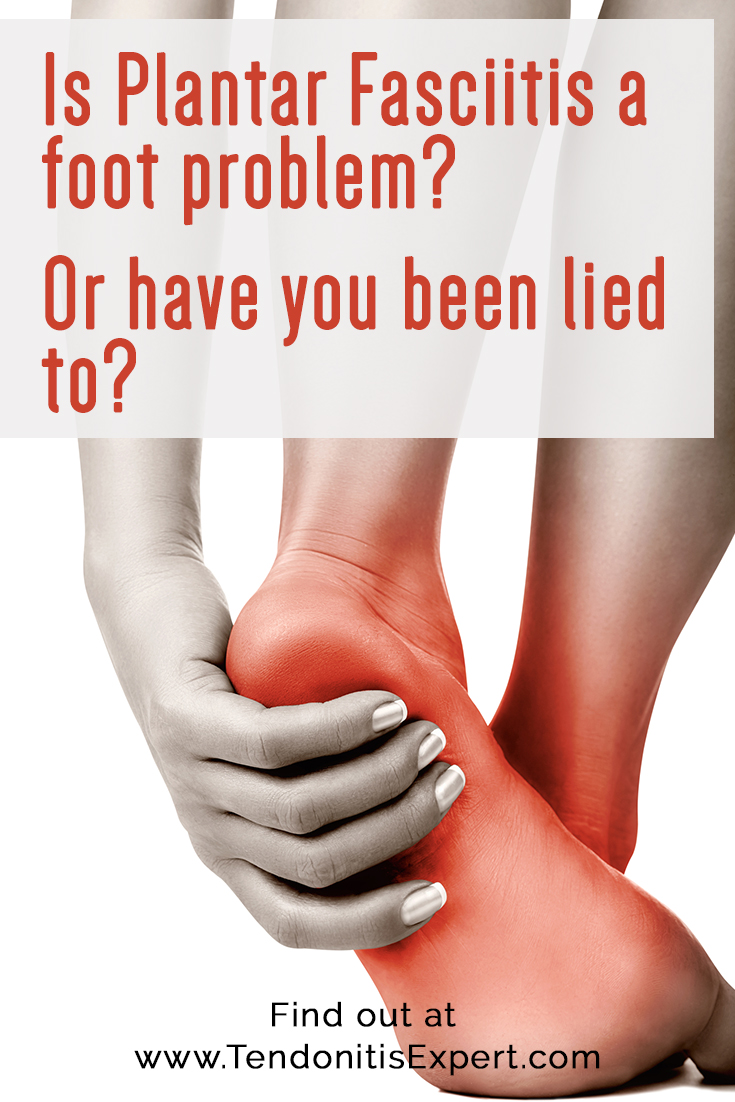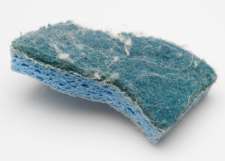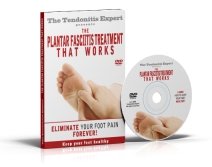Eliminate Plantar Fasciitis Pain
But First, Understand The
Real Problem
Do you have Plantar Fasciitis? General foot pain or sharp pain in the heel? Does it hurt when you get out of bed in the morning for the first several steps?
Did you know that Plantar Fasciitis is a form of Tendonitis?
Understand the Plantar Fascitis -tendonitis dynamic- and you understand how to heal fully, or mimimally, to manage your ‘injury’ and keep yourself pain and symptom free.
Plantar Fascitis is not just an injury (IF there's any injury at all, which is unlikely), it is a sign of an ‘unhealthy’ ecology in your foot.
Things aren't working correctly (in your lower leg). Which results in decrease of function and increase in symptoms in your foot.
Don’t worry though, it’s relatively easy to get everything working well again, and pain free. It will take some time and some effort.
What Is Plantar Fasciitis?
Plantar Fasciitis is generally considered to be pain in the heel and/or bottom of the foot, from inflammation of the plantar fascia (the connective tissue of the bottom of the foot).

Look around on other websites. That's pretty much the extent of the definition that you will find.
There's much more to it than that.
Important things to know about this kind of foot pain:
- Plantar Fascitis generally doesn't get better on it's own. Pain will come and go, staying longer and returning quicker.
- The usual recommended methods won't heal the damage like you think they should.
- Plantar Fascitis is preventable, manageable, and fixable if you have the RIGHT information.
- Just like foot pain after running tells us, Plantar Fasciitis isn't actually a foot problem, even though that's where the pain is.
First, let's give you the complete picture of Plantar Fasciitis so you understand what is going on.
Then, I'll tell you what you need to know to make the pain go away, and keep it away.
What Is Plantar Fasciitis, Really?
Plantar Fasciitis is a tendonitis dynamic.
Meaning, there are three primary factors causing a decrease in function and thus an increase in symptoms.
Over time as the dynamic progresses, the connective tissue can become (basically) like a dry, crunchy sponge.
I know that that sounds highly technical and medical.....but that's the most useful definition that you will ever find.
'Heel pain from inflammation' doesn't help you at all. You already know it hurts.
Do you want to know why it hurts?

Imagine a sponge, like the one you wash dishes with. Imagine a dry, hard sponge.
What happens when you squeeze a dry, hard sponge?
The dry brittle fibers of the tendon, tendon attachment, and/or the plantar fascia (sheet of connective tissue) crackle and break (in tiny tiny bits).
You can't really see any damage, but little tiny fibers are getting damaged every time you exert force on the sponge (like standing on your feet first thing in the morning.
That's What's Happening In
Your Foot!
If you have a 'dry' ecology in the structure of your foot, that is exactly what is happening every time you take a step.
Little tiny rips and tears in your tendons, ligaments, and connective tissue.
Farther down the page I'll describe the whole process, but for now know that rips and tears turn into a tightened structure, kind of like a half squeezed sponge.
What happens with a half squeezed sponge? Old stuff gets stuck in, and old stuff has a hard time getting out.
Waste product and other irritant gets trapped in your tissue.
Why That Small Foot Pain Got Worse
There are several contributing factors.
1. Something like 75% of Americans are chronically dehydrated.
So it's entirely likely that your sponge doesn't have enough water in it in the first place.
This is a player, but minor.
2. You don't eat enough protein.
You know that statistic that we lose a pound of muscle mass every year after the age of 35? That is almost entirely because we don't eat enough protein.
If you aren't eating enough protein, you don't have the building blocks necessary to appropriately heal all the little wear and tear injuries your body regularly sustains.
Bone Broth would be a great idea too.
But, this is a minor factor.
3. The Pain Causing Dynamic.
Tightness creates micro-injury and pain which creates more tightness which creates lack of circulation with creates more pain which creates more tightness.....
THIS IS THE MECHANISM TO PAY ATTENTION TO!
4. Process of Inflammation.
Injury (or when the brain perceives an injury that isn't actually there) causes a process of inflammation, which makes you hurt more, which makes the nervous system make your tissue more tight, which traps that inflammation, which makes things more tight and adds to the Pain Causing Dynamic.
And #5, THE LOWER LEG. Which, by the way, is 100% the cause of your foot pain.
The Lower Leg IS 100% The Actual Problem
Running, standing, walking, getting old, etc, are factors, but aren't the real problem.
The actual problem that causes foot pain and PF symptoms, is your lower leg(s).
Too tight muscles and connective tissue in your lower leg is the cause of your foot and Achilles attachment pain.
- The tighter a (lower leg) muscle is, the less strength potential it has. Like a half squeezed sponge, there's only half a squeeze left.
- The tighter a muscle is, the less able it is to absorb force, and all that force has to go somewhere (like your plantar fascia and/or achilles tendon attachment at the heel).
- The longer a muscle is tight, the tighter connective tissue shrinks down around it (half squeezed sponge tightly wrapped in saran wrap).
Then you're walking around and your feet are taking more force/load than they're supposed to...your too tight lower legs are causing overstretch of the tissue wrapping down to the heel and foot...
Eventually inflammation process starts and progresses.
Meanwhile, all the tightness and inflammation and pain (that you may or may not consciously feel) is eating up nutrition.
That's the tendontis dynamic: too tight muscle and connective tissue, inflammation process, and lack of nutrition.
ALL THREE FACTORS MUST BE DEALT WITH EFFECTIVELY IF YOU WANT TO FIX YOUR PLANTAR FASCIITIS.
Getting Out Of Bed In The Morning
Do It RIGHT Or ELSE
Yes, that’s correct.
Getting out of bed in the morning is where a lot of people feel a lot of pain..
Every morning you wake up, and jump out of bed onto the dry, brittle sponges of your feet.
Why? ('why' is always the most important question.)
When you wake up in the morning, you are metabolically at your 'coldest'.
This means that your tissue hasn't 'warmed up' yet.
Your foot structure is an arch, with millions of little connections that move and resist pressure when you put your weight onto the arch.
Over time, being chronically dehydrated, not eating enough protein, with the Tightness and the Inflammation and the Pain Causing Dynamic that is always entrenching itself in your body, the connective tissue on the underside of your foot, specifically the Plantar Fascia, starts turning into a dry, crunchy sponge, and is OVERSTRETCHED and OVERLOADED.
So every time you jump out of bed onto your cold, crunchy feet, you (can) get some micro-rip and tear.
That’s why those first several steps hurt. Injury, injury, injury.
If you’ll remember, before you had foot pain, you had foot discomfort.
Over time and daily micro-injury from getting out of bed, that discomfort turned to foot pain because you kept injuring yourself, and the Inflammation process from that damage built up more and more.
Then What Happens?
As years pass, it gets worse and worse. Eventually it becomes a real problem.
Most people exercise less, even move less, because their feet hurt. This makes the situation worse, plus most people gain weight as time goes by, putting more load on the dry, brittle structure of the foot.
This is stereotypical of the Tendonitis dynamic: Ache and pain that gets ignored for months and years, the injury gets worse little by little, then one day it shows up as a real problem.
Even when Planter Fasciitis looks to be caused by a one-time event like a long run, or jumping, the dynamic has actually been getting worse and worse, under the radar, until that one-time event took it over the edge.
Why do the first few steps hurt and then
the pain goes away?
What happens when you squeeze a dry sponge under running water?
It absorbs the water, and gets soft, squishy, and....spongy. When a sponge is wet, you just about can’t damage it.
It certainly isn’t brittle.
The same is true with your feet when you get up in the morning.
The first few steps cause little rips and tears, and jump starts the already present inflammation response.
As you keep walking around, blood pumps in, the tissue metabolically warms up, and your foot becomes soft and squishy.
Plantar Fasciitis Symptoms
Plantar Fasciitis is another name for Foot Tendonitis.
Plantar Fasciitis is one of many kinds of Tendonitis (click to see the others)
See What Is Tendonitis? to fully understand the Tendonitis dynamic.
Plantar Fascitis Tendonitis has its own set of symptoms. I’ve added more than the ‘official’ set you'll find on every other website because I find them to be incomplete and generic.
- Dull or sharp pain in the sole of your foot, and/or in the inside part of the bottom of your heel
- Foot pain that shows up for the first steps when getting out of bed in the morning, then goes away
- When standing up from a seated/resting position
- Foot pain that doesn’t go away after the first few steps.
- Foot pain when climbing stairs or when standing on tiptoe
- Foot pain when standing for long periods
- Foot pain after, and sometimes during exercise
- Inflammation/swelling in your heel
The most important concept to get here is that if you have foot pain in the morning that goes away after walking around for a bit, there is a pain causing dynamic in place that you need to start dealing with if you want the pain to stop progressing and go away.
Symptoms You Might Not Expect From Plantar Fascitis
Well, maybe not symptoms so much as repercussions.
- Cuboid Fracture. Not likely, but it's an example of the bad things that can happen when the foot and lower leg aren't working well.
- Knee Tendonitis. When foot and lower leg don't work well, force transfers up the leg.
- Hip Pain. Again, when the lower leg isn't absorbing force like to should be...that force has to go somewhere. Down to the foot, or up to the hip and low back, etc. Or realistically, both up and down.
Remember, when muscles can't absorb force like they're supposed to because they're too tight, that force has to go SOMEWHERE. Like to a bone (fracture), or up the leg (knee and/or hip problems).
Find more information about
Plantar Fasciitis Symptoms, including explanations of the causes of each individual symptom.
Plantar Fasciitis Surgery
Only a very small number of people are candidates for Plantar Fasciitis Surgery. Well, should be candidates, anyway.
It is a last ditch effort to do -something- to help.
After Rest and Anti-inflammatory drugs and Corticosteroid Injections fail to eliminate your Plantar Faciitis, doctors have no option left other than to recommend surgery.
It's called a Plantar Fasciotomy. This means that a surgeon cuts the Plantar Fascia away from it's connection to your heel bone.
That's like removing some pillars from a bridge you drive over every day.
Sound like a good idea?
The last thing you need is more weakening of the structure of the arch of your foot.
Many people turn to using a Plantar Fasciitis Support and that's fine, if you want to prolong your suffering. Here are 3 reasons to avoid using Plantar Fasciitis Support.
There are better options, that actually work.
Find out more about Plantar Fasciitis Treatment.
An Important Secret
About Plantar Fasciitis
The MOST important thing to know about Plantar Fasciitis, is that while you may feel pain in your foot, the foot is not the CAUSE of your pain.
You have symptoms and dysfunction in your foot, but that foot problem is CAUSED by something else.
Tight muscles and connective tissue in your lower leg connects to the connective tissue in your feet structures.
With each step, that TOO TIGHT muscle and connective tissue is constantly pulling too much on your feet. This adds up over time.
Even if the back of your legs FEEL fine, that doesn't mean that they're not causing all your foot pain.
If you're about to get surgery for a plantar fascia issue, ask your doctor if any of your symptoms could be being caused by the back of your lower leg. Ask them what EXACTLY they are going to cut on in your feet, and exactly how that's going to FIX the problem.
Here are some good questions to ask if you're about to get pf sugery: Quiz Your Doctor
To find out how you can correct the issue in your lower leg structures, get 'The Plantar Fasciitis Treatment That Works' (click to see more information) DVD and the Quick Start Companion ebook that comes with it.
Return to the top of this Plantar Fasciitis page
Go to the main Tendonitis page
Go to the TendonitisExpert.com homepage
| Share Your Story
|




